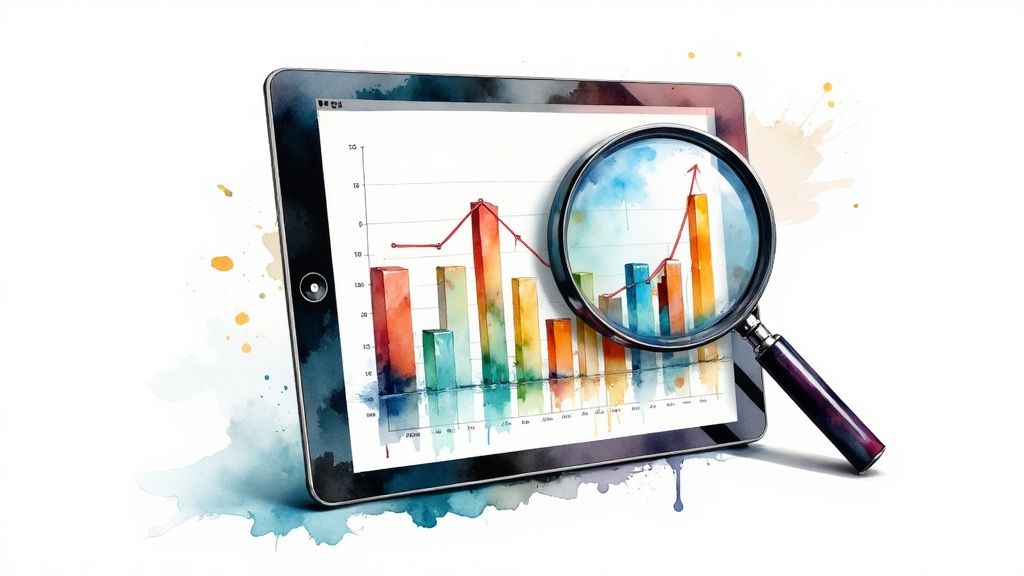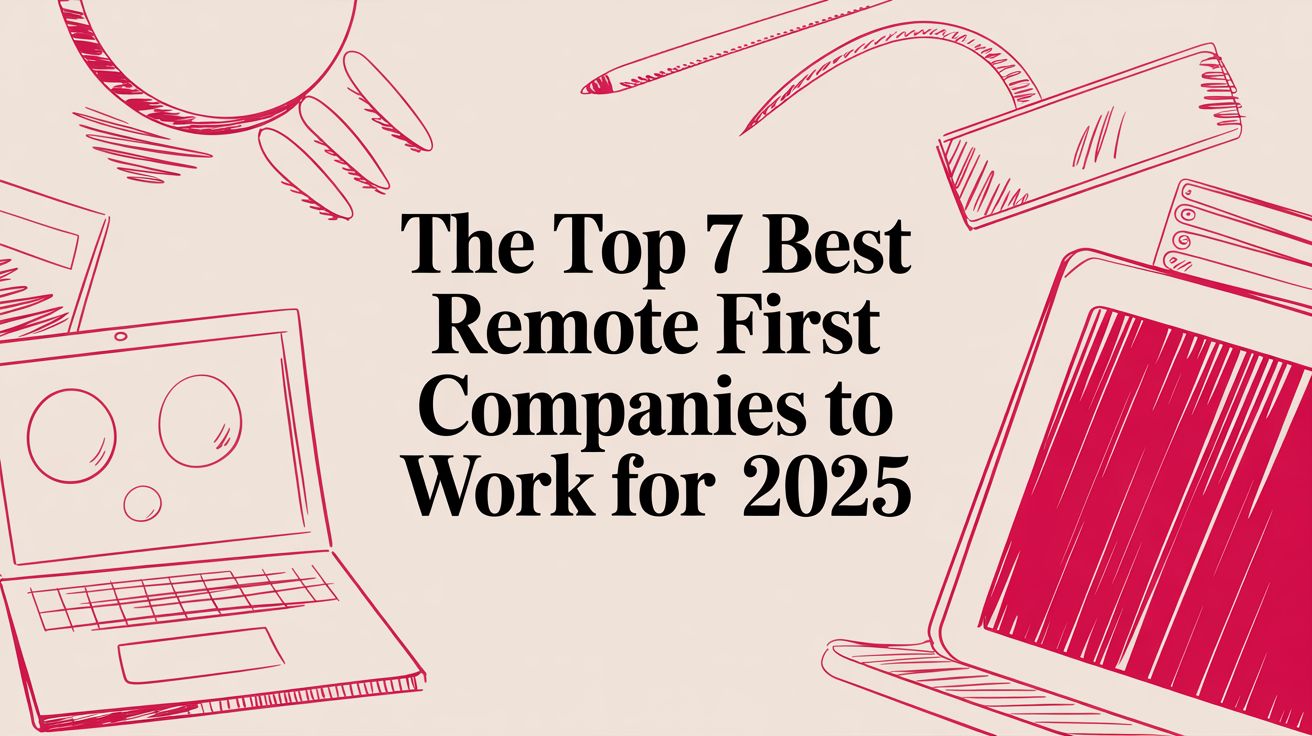8 Performance Management Best Practices for 2025
Max
In today’s remote-first landscape, the traditional annual review is no longer sufficient. High-performing organizations are shifting towards dynamic, continuous, and human-centric strategies to cultivate talent and drive results. This shift requires a new set of performance management best practices designed for the unique challenges and opportunities of a distributed workforce.
Gone are the days of recency bias and once-a-year feedback. The future is about fostering ongoing dialogue, leveraging data for objective insights, and focusing on employee development as the core engine of growth. This guide offers a comprehensive roundup of eight essential best practices that will transform your approach, boost engagement, and create a culture of excellence, no matter where your team is located.
We’ll explore actionable strategies, real-world examples from industry leaders, and practical implementation tips to help you build a system that truly works. Whether you’re a manager looking to empower your team or an HR leader redesigning your company’s framework, these insights will provide a clear roadmap for success. You will learn how to implement everything from continuous feedback loops and SMART goals to data-driven analytics and strengths-based coaching.
1. Embrace Continuous Performance Management
The era of the dreaded annual performance review is fading. One of the most impactful performance management best practices is shifting from this outdated, once-a-year model to a continuous, ongoing dialogue. Continuous performance management replaces the high-stakes annual meeting with frequent, informal check-ins, real-time feedback, and dynamic goal adjustments. This approach transforms performance discussions from a retrospective judgment into a forward-looking, developmental partnership between managers and employees.

In a remote-first environment, this constant communication is not just a best practice; it’s a necessity. It keeps teams aligned, fosters a sense of connection, and allows managers to address roadblocks before they derail projects. This consistent interaction is fundamental to establishing psychological safety, a key component in building trust within virtual teams.
Real-World Success Stories
Many forward-thinking companies have successfully made this shift, proving its effectiveness.
- Adobe: After eliminating annual reviews in 2012 for their “Check-In” system, the company saw a significant increase in engagement and a reduction in voluntary attrition.
- Microsoft: The tech giant replaced its controversial “stack ranking” system with a continuous coaching model, leading to improved collaboration and innovation across teams.
- GE: Once known for its “rank and yank” policy, GE moved to ongoing developmental conversations, which greatly improved employee morale and satisfaction.
How to Implement Continuous Performance Management
Transitioning to this model requires a strategic approach rather than simply scheduling more meetings.
- Train Your Managers: Equip leaders with skills in delivering constructive feedback, active listening, and coaching.
- Leverage Technology: Use platforms like 15Five, Lattice, or even shared documents to schedule, track, and document regular check-ins.
- Focus on the Future: Frame conversations around development, upcoming goals, and problem-solving, not just past performance mistakes.
- Keep It Consistent: Aim for brief (15-30 minute) but regular sessions, such as weekly or bi-weekly, to maintain momentum.
2. Implement the SMART Goals Framework
Setting clear, unambiguous expectations is a cornerstone of effective performance management. The SMART Goals framework provides a simple yet powerful methodology for achieving this clarity. It ensures objectives are Specific, Measurable, Achievable, Relevant, and Time-bound. This approach removes guesswork, providing a transparent roadmap for what employees need to accomplish and how their success will be measured.

When applied correctly, SMART goals create a direct link between an individual’s daily tasks and the company’s broader strategic objectives. This alignment is crucial in remote settings, where it helps employees feel more connected to the mission and understand the impact of their contributions. The framework, first articulated by George T. Doran, builds upon Peter Drucker’s “Management by Objectives” concept to create actionable, motivating targets.
Real-World Success Stories
Many of the world’s most successful companies integrate SMART principles into their performance systems.
- Google: The company’s famous Objectives and Key Results (OKR) system inherently uses SMART criteria. Key Results are designed to be measurable and time-bound, while a target of 70% achievement keeps them ambitious yet achievable.
- Intel: A pioneer in performance management under Andy Grove, Intel has long used SMART goals in conjunction with its quarterly business reviews to drive accountability and high performance.
- Coca-Cola: The global beverage leader applies the SMART framework at every level, from individual contributor goals to executive-level strategic initiatives, ensuring organization-wide alignment.
How to Implement the SMART Goals Framework
Simply knowing the acronym isn’t enough; effective implementation is key to leveraging this performance management best practice.
- Involve Employees: Collaborate with employees during the goal-setting process to increase their ownership and buy-in.
- Review and Adjust: Revisit goals quarterly to ensure they remain relevant to changing business priorities and employee development needs.
- Use Action Verbs: Write goal statements with specific action verbs and quantifiable metrics, for example, “Increase lead-to-customer conversion rate by 15% in Q3.”
- Connect to the Bigger Picture: Clearly articulate how an individual’s SMART goal contributes to team and company-wide objectives.
- Track Progress Visibly: Use performance management tools or shared dashboards to track progress and celebrate milestones, keeping motivation high.
3. Implement 360-Degree Feedback
To gain a truly comprehensive understanding of an employee’s contribution, another of the most effective performance management best practices is implementing 360-degree feedback. This method moves beyond the traditional top-down review by gathering confidential, anonymous feedback from a full circle of colleagues. This includes input from the employee’s manager, peers, direct reports, and sometimes even external clients, providing a well-rounded view of their skills, behaviors, and impact.

This multi-perspective approach is invaluable in a remote setting where a manager’s visibility might be limited. It uncovers blind spots and highlights strengths that might otherwise go unnoticed, offering a more objective and holistic dataset for developmental conversations. It also empowers employees by giving them a structured way to contribute to their colleagues’ growth, fostering a culture of mutual accountability and support. Learning how to ask for feedback at work is a critical skill this process reinforces.
Real-World Success Stories
Many influential organizations use 360-degree feedback to cultivate strong leaders and high-performing teams.
- Johnson & Johnson: The company uses this method for leadership development, with reports indicating that 85% of participants demonstrate improved performance after receiving 360-degree feedback.
- IBM: With a workforce of over 170,000, IBM integrates 360 reviews directly into its career development and planning processes, helping employees identify clear paths for growth.
- General Electric: Historically, GE utilized 360-degree feedback as a core component of its leadership assessment process, pioneered under Jack Welch to identify and develop top talent.
How to Implement 360-Degree Feedback
Rolling out a successful 360-degree feedback program requires careful planning and clear communication.
- Ensure Anonymity: Use a trusted third-party tool or an internal system that guarantees confidentiality to encourage candid and honest responses.
- Train All Participants: Provide clear guidelines and training on how to give and receive constructive, behavior-based feedback, not personal criticism.
- Focus on Development: Position the process as a tool for growth and development, not as a direct input for compensation or promotion decisions, to reduce anxiety and increase buy-in.
- Provide Coaching: Follow up with dedicated coaching sessions to help employees interpret their results, create an action plan, and focus on key developmental areas.
4. Strengths-Based Performance Management
A transformative approach to employee development is to shift the focus from correcting weaknesses to amplifying strengths. This performance management best practice involves identifying, developing, and strategically leveraging each employee’s natural talents. Strengths-based management recognizes that individuals deliver their best work and are most engaged when their roles align with their innate abilities. This method moves beyond traditional performance reviews that often over-index on shortcomings.

Popularized by thought leaders like Donald O. Clifton and Marcus Buckingham, this philosophy is particularly effective in remote settings where autonomy is high. By empowering employees to work within their areas of strength, managers can foster greater ownership, innovation, and job satisfaction without constant supervision. The goal is to build a high-performing team where individual talents are recognized and intentionally cultivated.
Real-World Success Stories
Organizations that adopt a strengths-based culture see tangible improvements in productivity and engagement.
- Gallup: Their research consistently shows that teams focused on strengths experience 10-19% increased sales and 14-29% increased profit.
- Best Buy: The retail giant implemented strengths-based management and reported a stunning $40 million increase in productivity across its operations.
- Facebook: The social media company integrates strengths assessments into its hiring and team formation processes to create well-rounded, complementary teams.
How to Implement Strengths-Based Performance Management
Putting this theory into practice requires a deliberate and supportive strategy.
- Use Validated Assessments: Employ tools like the Gallup CliftonStrengths or VIA Survey to help employees identify their core talents.
- Train Your Managers: Coach leaders to become “strengths spotters” who can recognize, articulate, and develop the strengths of their team members.
- Align Roles and Strengths: Design job roles and assign projects that allow employees to regularly use their top strengths.
- Build Complementary Teams: When forming project teams, consider a mix of strengths to ensure all necessary perspectives and skills are present.
- Integrate into Conversations: Make discussing strengths and how to apply them a regular part of one-on-ones and performance check-ins.
5. Regular Calibration Sessions
To ensure fairness and consistency, performance evaluations cannot happen in a vacuum. A crucial performance management best practice is implementing regular calibration sessions. These are structured meetings where managers convene, often with HR professionals, to discuss and align their employee performance ratings. This process helps to mitigate individual manager bias, standardize evaluation criteria across different teams, and ensure that assessments are equitable and evidence-based.
In remote and hybrid settings, where managers have varying levels of visibility into their team’s work, calibration is vital. It prevents “proximity bias” where onsite employees might be perceived more favorably and ensures that performance is judged on outcomes and behaviors, not just visibility. These sessions create a shared understanding of what “high performance” looks like, fostering a more just and transparent culture.
Real-World Success Stories
Many organizations rely on calibration to maintain integrity in their performance systems.
- Amazon: The company famously conducts quarterly calibration sessions within all business units to maintain consistent performance standards and make informed talent decisions at scale.
- PwC: This global professional services firm uses calibration meetings to ensure that performance ratings and subsequent rewards are applied equitably across its vast network of global offices.
- Spotify: To support its continuous feedback model, Spotify implements calibration sessions that help align manager assessments and ensure fairness in developmental and compensation discussions.
How to Implement Regular Calibration Sessions
Effective calibration requires more than just getting managers in a room; it demands structure and preparation.
- Prepare with Evidence: Require managers to come to meetings with specific, documented examples of employee behaviors and outcomes to support their ratings.
- Use a Structured Format: Implement a clear agenda, use a facilitator, and allocate specific times for discussing each employee to keep the conversation focused and productive.
- Ensure Diverse Panels: Include a diverse group of managers and HR partners in each session to challenge potential biases and provide different perspectives.
- Focus on Behaviors, Not Traits: Guide the discussion to center on observable actions and measurable results rather than subjective personality assessments.
- Document Everything: Keep a clear record of the discussion points, final decisions, and the rationale behind them for transparency and future reference.
6. Development-Focused Performance Discussions
Shifting performance conversations from evaluative judgments to developmental dialogues is a cornerstone of modern performance management best practices. This approach redefines the purpose of performance discussions, focusing on an employee’s growth, skill acquisition, and long-term career path. Instead of just rating past contributions, managers act as coaches, collaborating with employees to identify opportunities for improvement and co-create actionable development plans.
This forward-looking perspective is incredibly powerful in a remote setting. It demonstrates a company’s investment in its people beyond their immediate output, fostering loyalty and engagement. When employees see a clear path for growth within the organization, they are more motivated, productive, and less likely to seek opportunities elsewhere. This method ensures that performance management is a tool for empowerment, not just assessment, which is crucial for preparing for a performance review that feels constructive.
Real-World Success Stories
Leading companies have embraced developmental conversations to build stronger, more skilled teams.
- Netflix: The company famously avoids formal reviews and ratings, instead fostering a culture of radical candor where continuous feedback is centered on professional growth and skill enhancement.
- LinkedIn: Performance management at LinkedIn heavily emphasizes career development conversations, encouraging internal mobility and helping employees map out their next steps within the company.
- Salesforce: Performance discussions are framed as development planning sessions, ending with clear, mutually agreed-upon action items and goals for the upcoming period.
How to Implement Development-Focused Discussions
Making this transition requires managers to adopt a coaching mindset.
- Ask Future-Focused Questions: Start conversations by asking about career aspirations, interests, and what skills the employee wants to build next.
- Identify Specific Competencies: Work together to pinpoint the exact skills, knowledge, or behaviors needed for the employee to advance toward their goals.
- Create SMART Development Goals: Establish specific, measurable, achievable, relevant, and time-bound objectives for their growth plan.
- Provide Resources and Stretch Assignments: Support development by offering access to training, mentorship, or challenging projects that build new skills.
- Track Progress Regularly: Schedule follow-ups to discuss progress, offer support, and adjust the plan as needed. For instances where employees need targeted support, a structured performance improvement plan template can provide a clear path forward.
7. Real-Time Recognition and Feedback
Waiting for a quarterly or annual review to praise great work or offer guidance is a missed opportunity. One of the most dynamic performance management best practices is to integrate real-time recognition and feedback into the daily workflow. This approach ensures that acknowledgment is timely and constructive guidance is delivered when it’s most relevant, transforming feedback from a formal event into a continuous, impactful conversation.
This immediacy reinforces positive behaviors and corrects missteps before they become ingrained habits or larger issues. In a remote setting, where employees can feel isolated, instant feedback serves as a crucial point of connection and validation. It shows that their contributions are seen and valued, which is a cornerstone for building a thriving remote work culture. This practice directly fuels motivation and engagement by making employees feel consistently supported.
Real-World Success Stories
Companies that master real-time feedback often see significant gains in morale and productivity.
- Bonusly: This platform is built around real-time peer recognition. Employees can give small, points-based bonuses to colleagues, creating a constant stream of positive reinforcement that is visible across the company.
- HubSpot: The company culture encourages immediate feedback through practices like their “GSD (Get Stuff Done) Reviews,” which prioritize swift, direct, and helpful communication to keep projects moving.
- Zappos: Known for its unique holacracy model, Zappos embeds real-time feedback and recognition directly into its operational system, empowering employees to acknowledge contributions and address issues as they arise.
How to Implement Real-Time Recognition and Feedback
Making feedback a daily habit requires both cultural and structural support.
- Use the SBI Model: Train teams to structure feedback using the Situation-Behavior-Impact model. This makes feedback specific and actionable, not personal.
- Implement Recognition Platforms: Use tools like Bonusly or Motivosity that allow for easy, public, and peer-to-peer recognition.
- Train for In-the-Moment Delivery: Coach managers and employees on how to give and receive feedback constructively and promptly, whether it’s praise or guidance.
- Create Feedback Rituals: Integrate quick feedback opportunities into existing routines like daily stand-ups or team huddles to make it a natural part of the workday.
8. Data-Driven Performance Analytics
Intuition and observation have their place, but a truly modern strategy incorporates data-driven performance analytics to make talent management objective, predictive, and transparent. This approach involves using quantitative metrics and analytics tools to measure performance, track trends, and identify patterns. By leveraging technology, organizations can move beyond subjective assessments to make evidence-based decisions that drive improvement and fairness.
In a remote setting, where direct observation is limited, data provides an unbiased lens into productivity, collaboration, and engagement. It helps managers pinpoint where an employee is excelling or struggling, offering clear evidence to support coaching conversations. This quantitative foundation is a cornerstone of effective performance management best practices, ensuring decisions are based on facts, not feelings.
Real-World Success Stories
Leading companies use people analytics to gain a competitive edge in talent management.
- Google: The company’s famous People Analytics team uses data to identify the traits of high-performing teams and managers, which then informs their training and development programs.
- IBM: Leveraging its own Watson Analytics, IBM can analyze employee data to predict flight risk and identify performance trends, allowing for proactive intervention.
- Workday: As a provider, Workday offers comprehensive performance analytics that help enterprise clients correlate performance metrics with business outcomes, demonstrating the direct impact of talent management.
How to Implement Data-Driven Performance Analytics
Adopting a data-first mindset requires more than just buying software; it’s a cultural shift.
- Focus on Leading Indicators: Track metrics that predict future success (e.g., skill development, project milestone completion) rather than just lagging results (e.g., annual sales figures).
- Balance Quantitative with Qualitative: Combine hard data with qualitative feedback from check-ins to create a holistic performance picture. This is crucial for roles where contributions are less easily quantified.
- Train Managers on Data Literacy: Equip leaders to interpret data correctly and use it to facilitate constructive, evidence-backed conversations. This skill set is a key part of what data analyst job requirements often include.
- Ensure Data Privacy: Be transparent with employees about what data is being collected and how it will be used, ensuring ethical practices and maintaining trust.
- Identify Development Opportunities: Use analytics to pinpoint skill gaps across teams or the organization. To truly understand the impact of your development programs, consider delving into resources on Measuring the ROI on Training.
Performance Management Best Practices Comparison
| Methodology | Implementation Complexity 🔄 | Resource Requirements ⚡ | Expected Outcomes 📊 | Ideal Use Cases 💡 | Key Advantages ⭐ |
|---|---|---|---|---|---|
| Continuous Performance Management | High (frequent check-ins, training needed) | High (manager time and coaching skills) | Increased engagement, faster issue resolution, better alignment | Fast-paced environments needing ongoing alignment | Reduces recency bias, improves manager-employee relationship |
| SMART Goals Framework | Moderate (structured goal setting) | Moderate (time for goal design, tracking) | Clear, measurable goals, higher achievement rates | Organizations needing clarity and accountability | Eliminates ambiguity, increases goal attainment |
| 360-Degree Feedback | High (multi-source collection, training) | High (admin, training, tools) | Comprehensive insights, self-awareness, reduced bias | Leadership development, holistic performance reviews | Identifies blind spots, reduces single-source bias |
| Strengths-Based Performance Management | Moderate-High (assessments, role alignment) | Moderate-High (assessments, training) | Higher engagement and productivity, reduced turnover | Teams focusing on talent optimization | Boosts motivation, improves team collaboration |
| Regular Calibration Sessions | High (coordination, skilled facilitation) | Moderate-High (time and preparation) | Consistent, fair evaluations, improved manager confidence | Large orgs wanting standardized performance ratings | Reduces bias, ensures fairness across teams |
| Development-Focused Discussions | Moderate (manager coaching skills required) | Moderate (development resources) | Increased motivation, retention, and capability growth | Growth-focused cultures, career development emphasis | Builds trust, creates development culture |
| Real-Time Recognition and Feedback | Moderate (tech setup and discipline) | Moderate (platforms and training) | Increased motivation, faster corrections, continuous improvement | Cultures valuing agility and immediate feedback | Reinforces behaviors timely, boosts engagement |
| Data-Driven Performance Analytics | High (tech investment and training) | High (analytics tools and expertise) | Objective insights, evidence-based decisions, trend identification | Data-centric organizations focused on metrics | Enables data-driven decisions, identifies patterns |
Building Your High-Performance Remote Culture
Transitioning from traditional, often dreaded, annual reviews to a dynamic and supportive performance management system is a significant cultural shift. It’s a journey, not a destination. The eight strategies we’ve explored, from embracing continuous feedback loops and SMART goals to leveraging 360-degree feedback and data-driven analytics, form a comprehensive blueprint. However, the true power of these performance management best practices lies not in implementing them as a checklist, but in weaving them into the very fabric of your remote work culture.
The most crucial takeaway is that modern performance management is fundamentally human-centric. It moves beyond simply measuring output to actively fostering growth, engagement, and psychological safety. This means prioritizing development-focused discussions over critiques, celebrating wins with real-time recognition, and using calibration sessions to ensure fairness and eliminate bias. The goal is to create a transparent system where every team member understands what success looks like and feels supported in their efforts to achieve it.
Charting Your Course: Actionable Next Steps
To begin transforming your approach, don’t try to boil the ocean. Instead, focus on incremental, high-impact changes.
- Start with Conversations: Before introducing new tools or processes, train your managers to have better one-on-one conversations. Focus on building trust and shifting the dialogue from evaluation to development. This is the foundation upon which everything else is built.
- Integrate Two Core Practices: Begin by combining real-time feedback with a revised SMART goal-setting process. This creates immediate clarity and a continuous-improvement cadence that delivers early wins and builds momentum for more significant changes.
- Leverage Your Data: Use performance analytics not as a surveillance tool, but as a diagnostic one. Identify trends, pinpoint areas where teams may need more support, and validate the fairness of your promotion and compensation decisions.
Ultimately, the goal of modern performance management is to foster a high-performing culture by implementing proven strategies to increase team productivity. When employees feel seen, valued, and invested in, their motivation and output naturally increase. This isn’t just about better processes; it’s about building a resilient, adaptable organization where your team can do their best work, regardless of physical location. By committing to these modern, empathetic, and effective performance management best practices, you are not only elevating your current team but also creating a powerful competitive advantage in the war for talent. You are building an environment where excellence is the standard and every employee is empowered to thrive.
Ready to attract top professionals who thrive in a high-performance, well-managed remote environment? Post your job openings on Remote First Jobs to connect with a curated pool of candidates already accustomed to the autonomy and accountability that modern performance cultures demand. Find your next great hire at Remote First Jobs and build the team that will drive your company forward.


